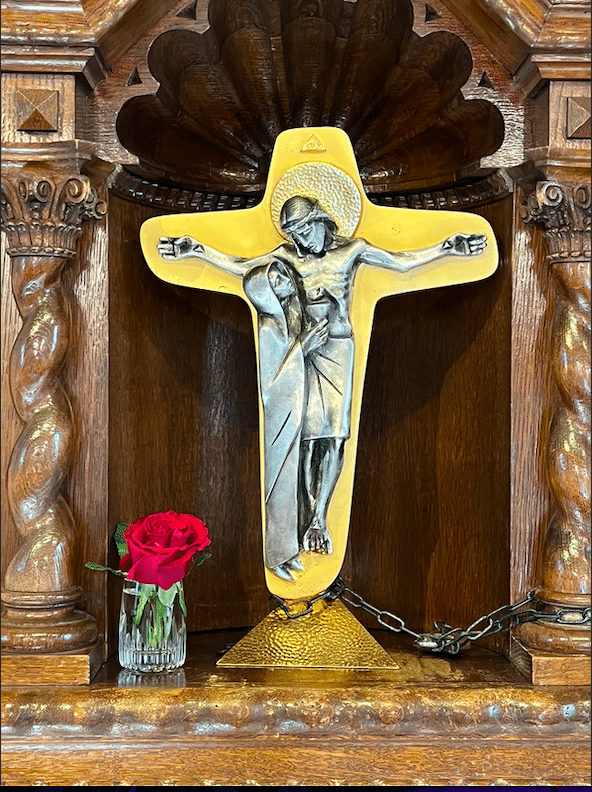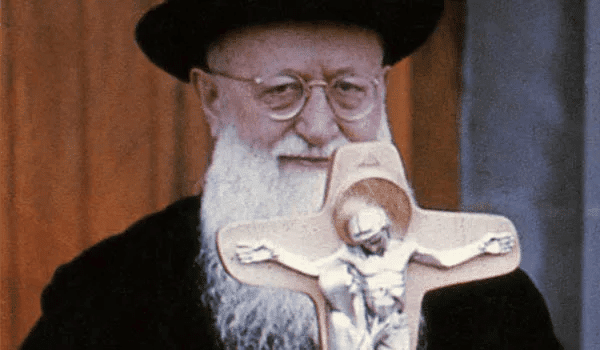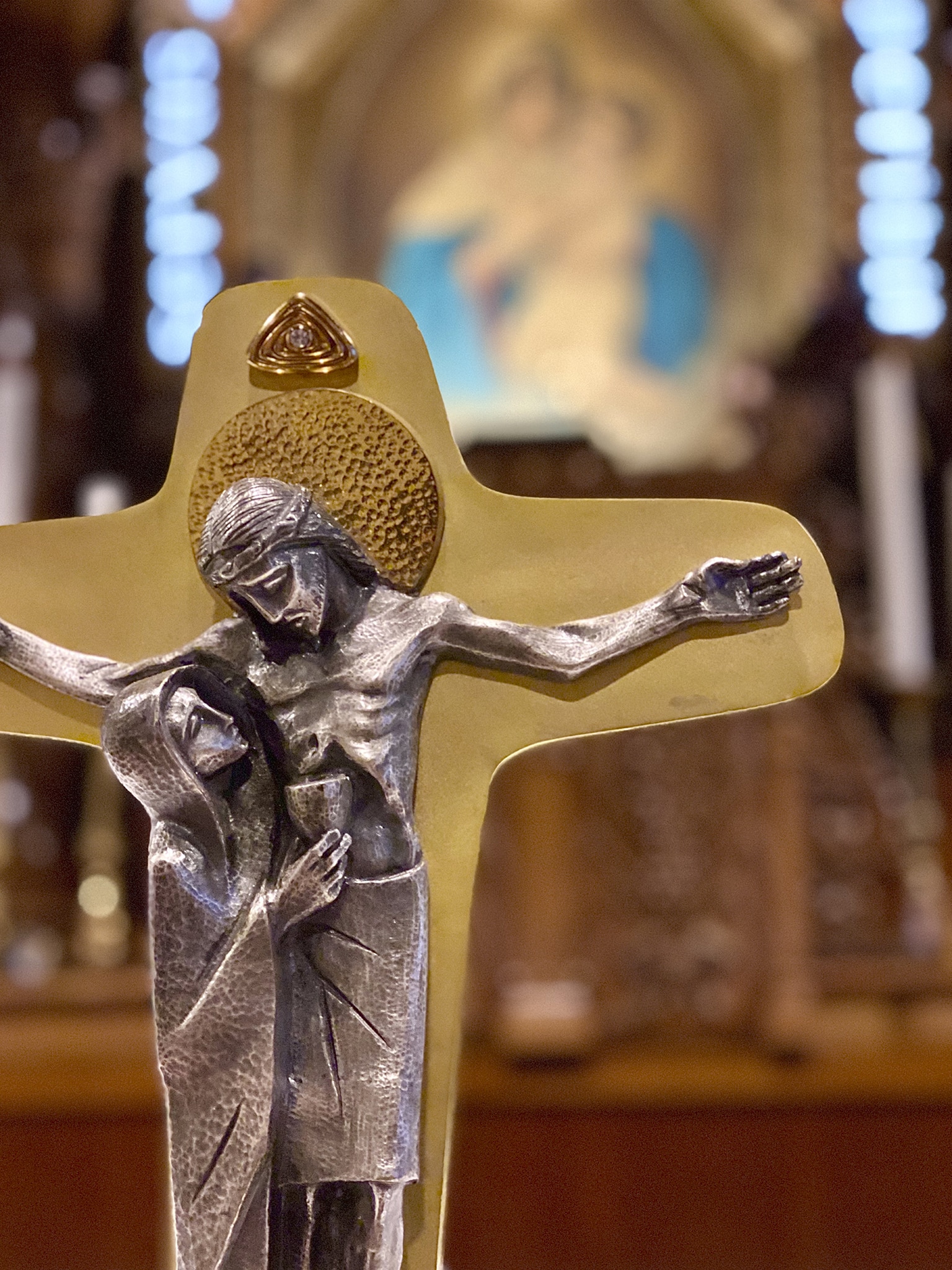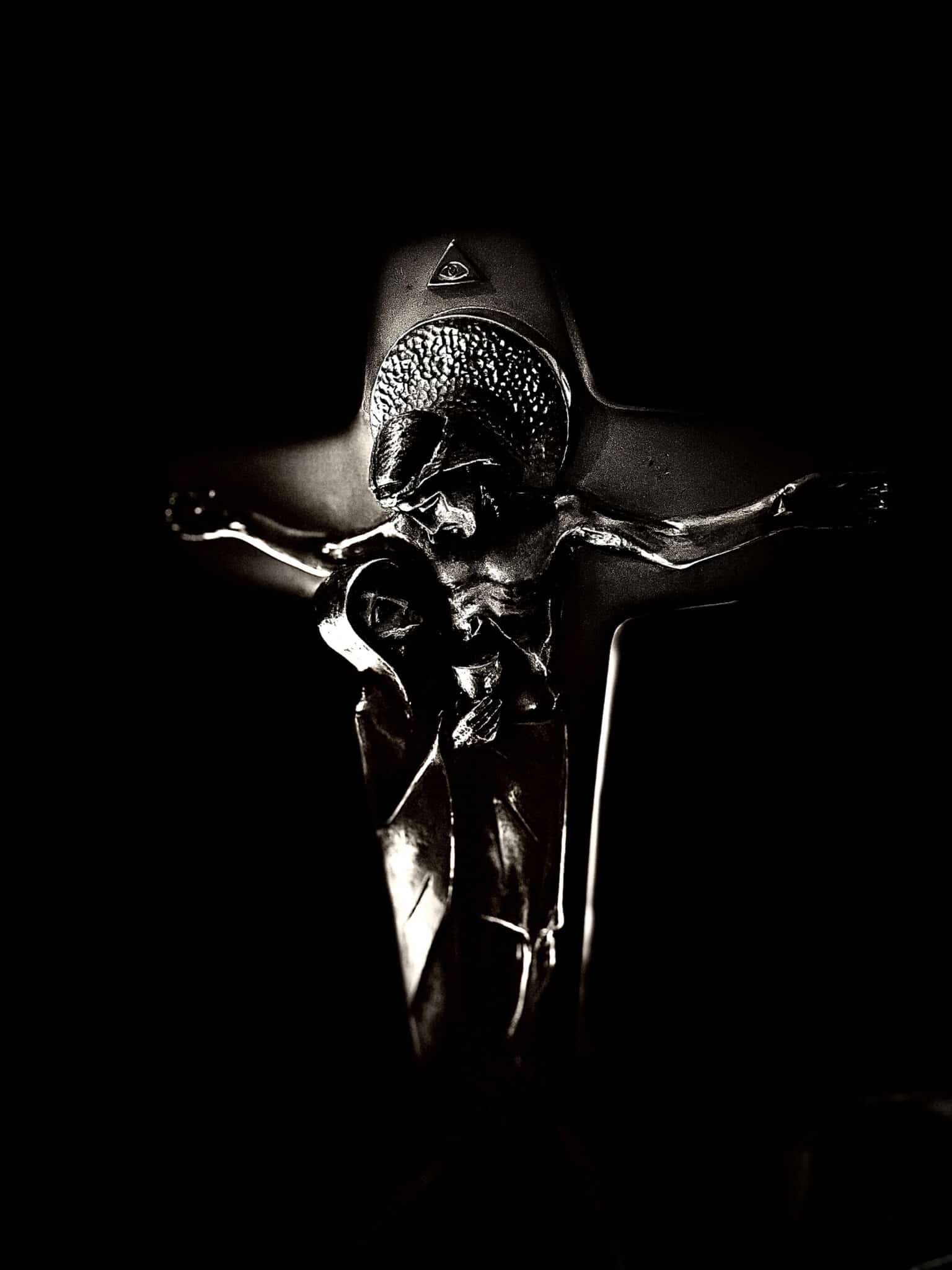A very blessed Feast of the Exaltation of the Cross, to you, my friend! This is one of my favorite feasts of the year and I would say it’s highly underrated and largely unnoticed. What can we take away from this day dedicated to lifting up the Cross? What does the Cross of Christ have to say to our reality today? As we reflect on these questions, we have the gift of contemplating a very unique cross to inspire us: the Schoenstatt Unity Cross.
An Invitation to Contemplation
Today the Unity Cross is known around the world. This week I actually had someone say to me, “Wait, the Unity Cross came from Schoenstatt? I thought someone famous designed it!” Their comment definitely made me chuckle!
Yes, the Unity Cross was born out of the life of the Schoenstatt Movement, in a dramatic and real-life story that unfolded in the lives of concrete people and communities. If you are interested in the whole story, I highly recommend both the “The Unity Cross” by Fr. Benjamin Pereira, and also the book by the same title by Gertrude Pollak, Lady of Schoenstatt.
I would like to share a brief sketch of that complex history today in order to show God’s creativity and ingenuity, as expressed through human instruments. You see, we are so incredibly inundated today by images, gifs and reels that I think we’ve lost the capacity to contemplate a masterpiece. And the Unity Cross is one such masterpiece in that it is a symbol, an icon, and as such has the potential to lead our little lives into the heart of the supernatural — if we let it.
And this symbol was born out of a lived experience…! Saturated as we are by the instantaneous culture of the immediate, we also forget how most often that which is truly beautiful comes out of a long life process. May this reflection today, my friends, invite you to slow down to contemplate this symbol, and thus re-encounter the absolute mystery of the Cross of Christ in our Catholic faith, in the world today.

Brief History
The Unity Cross was originally designed by the generation of Schoenstatt Fathers whose Ideal was “Unim in Sanguine” (united in the Blood of Christ) during those difficult years when Fr. Kentenich was in exile in Milwaukee, Wisconsin.
As Fr. Benjamin writes:
“a desire was born in us to give a crucifix to Bellavista, the place where our vocation was born and nourished, which would express our image of Christ the priest, just as we desired to live it out in the Covenant of Love with Mary and the lived experience of Christ of our Founder (Fr. Kentenich).The central thought that we wanted to express was the Christ of attachments. This is the Christ that, in the strength of the Holy Spirit, is deeply and intimately attached as Son to the Father. It is the Christ who is deeply and intimately attached to Mary, his Mother, constituted as His permanent Collaborator and Companion in His redemptive mission for mankind. It is the Christ of Unity who unites heaven and earth; it is Christ the Good Shepherd that, reflecting the love of the Father, unites people to God and people among themselves; making them children of the same Father.”
And so it happened, that this cross was forged by Fr. Angél Vicente Cerró, an artist and Schoenstatt Father. It was placed in the Bellavista Shrine for the first time during Christmas Eve Mass of 1960 by Fr. Humberto Anwandter, the first priest ordained in that generation of Unum In Sanguine. The moment it was placed there, God had also been working out a parallel life process at the same time in the local Bellavista Schoenstatt Family. For reasons I won’t go into here, a division had been growing for some time, and many felt it was becoming impassable. It is said that the process of healing had its “visible beginning” in that very moment that the Unity Cross was enthroned in the Bellavista Shrine.
At this point, Fr. Kentenich was still in exile. Many groups were working to bring him home, making many diplomatic efforts through contacts in Rome and also through offering prayer and sacrifice. Every community was offering and praying, hoping that the Founder could be reunited with the Movement before he died (he was almost 80 by now).
For the sake of this brief history of the Unity Cross, one of those lifestreams of offering for his return was within the Ladies of Schoenstatt community in the Stuttgart Region in Germany. This lifestream now has the name “the Bellavista-Stuttgart Parallel” because it is linked to the Bellavista Shrine and its Mission of May 31st, 1949, and the Stuttgart Shrine in Germany. The histories of the Shrines of Bellavista and Stuttgart unfolded in a parallel way. As a sign of gratitude for all of this offering, Fr. Kentenich gave the Original Unity Cross to the Stuttgart Shrine after the exile, and that is where it still lives today

In this way, the Unity Cross came to be out of a living history, and as such, has deep meaning for those who were part of that history. But God’s creativity did not stop there! Eventually the first copy was made in 1969, forged by the Brothers of Mary, and sent to Bellavista by the Ladies as a gift in return, and later on, more copies were made. Thus the wider Schoenstatt family came to know and love it as a symbol of our spirituality. The Unity Cross was especially present during the 2014 Jubilee and was known as the “Cross of the Mission”, since it captures Schoenstatt’s mission of proclaiming the Covenant of Love with Mary as a sure way to living in union with Christ.
And the Unity Cross continues to be found as a deep symbol even beyond Schoenstatt. Mother Theresa adopted the Unity Cross, discovering that for her, it symbolized her own community ideal of Christ saying “I thirst” from the Cross, and “Like Mary to stand by the Cross of the Dying Christ and to meet him there.” (Cited from the Aleteia article linked above). And more recently, Christopher West has adopted it as an image that represents the message that he spends his life to share: John Paul II’s Theology of the Body. At a recent meeting with Schoenstatt pilgrims at World Youth Day, Christopher West used the Unity Cross as his main theme, explaining that the way Mary receives the blood of Christ in the Chalice as Christ gives his life for His bride — thus collaborating together in the salvation of the world — shows the ideal that we should all strive for in the complementarity of men and women (paraphrased from personal notes, not a direct quote).
And the living story continues. Read more here about how that first replica of the Unity Cross was stolen from Bellavista in April of this year. Even now the Schoenstatt Family in Bellavista is discerning how to reconquer it.
The Cross of Christ in Today’s World
So what can the Unity Cross say to you today, on this Feast of the Exaltation?
Someone recently said to me, “That’s the most Catholic crucifix I’ve ever seen. Because not only is Jesus there, but Mary is there too!” He thought that adding Mary made it “extra Catholic,” and I think he was on to something!
What does that tell us? Symbolizing Jesus as the Christ of Attachments, it shows us that we are never alone in our suffering. Even Jesus was not alone on His cross! His Father was with Him (did He not cry out to the Father from the cross?) and His Blessed Mother was standing at His side: attentive to His suffering, steadfast, united to Him. Surely her steady gaze gave Him courage when all His most loyal followers had fled.

Today in our world obsessed with gaining pleasure and avoiding suffering, we can get used to carrying our crosses in isolation and avoiding others when we’re struggling. And sometimes we resist the suffering itself instead of allowing God to use it to transform us. We have forgotten how to suffer well. But Jesus gave us a different example! And Schoenstatt brings that message today to the world: Jesus and Mary go together. We see this reflected in the “Concluding Prayer” of the Way of the Cross of God’s instruments, written by Fr. Kentenich in Dachau (which by the way, he finished writing on September 13th, 1944, the eve of the Feast of the Exaltation of the Cross!).
“Let me present the Cross and the picture of Mary
to the nations as the sign of redemption
So that two who stand as one in the Father’s plan of love
may never be divided.”
It is precisely this awareness and lived experience of not being alone in our sufferings that gives us the courage to embrace daily life with God, and move through the suffering with Him. This is what living in Covenant with Mary and through her with the Triune God is about. The prayer continues:
“Let me proclaim you both to those around me,
daring my life’s battle for you each day.
Then your kingdom will be victorious everywhere
and extend its boundaries to the ends of the universe.”
– Fr J. Kentenich
We can dare to engage in the battle of life — one day at a time — because we are never alone.
The Daily Mystery of Death and Resurrection
This leads us to our last point of reflection on the Unity Cross for today: the interwoven mystery of crucifixion and resurrection in Jesus’ life and in our own daily lives united to Him.
Fr. Benjamin stresses the symbolic character of the Unity Cross in his book. He says that “How this moment [of the crucifixion] is represented has a strong symbolic character, even unhistorical in several aspects, such as representing Christ alive gazing at His Mother with the open wound in His side, being that in the biblical narration it says that His side was pierced after His death.”
What does this tell us? I think it invites us to search for Christ’s gaze and keep our eyes fixed on Him, like Mary always did, so that in the midst of difficulties we can already glimpse the hope of the resurrection. The darkness in the world always comes with hopelessness, and the Light of Christ always brings hope. When we contemplate the Unity Cross, we have a striking image of both death and resurrection at the same time.
See how the prayer continues:
“I want to plant you deeply in my joyous heart,
and constantly give you all my love;
my life’s hope is built on you, my crucified Lord,
and on your Bride.”
– Fr J. Kentenich
My hope is built on you…! That doesn’t mean the darkness isn’t dark, or the suffering isn’t difficult. It means that God the Father is behind it — in the same way He permitted His Son to bear the Cross — and that the Father is always reaching out for us, working out His plan of love in that same moment. It means that Christ has already found a way through and wants to give us hope right now.

Have you ever thought that it’s strange to focus both on the Crucifixion of Good Friday and also on the hope of Easter Sunday? Sometimes people overfocus on the Crucifixion, and it’s like they forget how the story ended. And sometimes people want to only think about the Resurrection, but then they forget what it cost, what the pathway towards it was. For us as Catholics, both realities always go together. And if we listen to this mystery in our daily lives we can walk with more steadiness and assuredness towards the hope of Christ, hastening like Mary to serve others in love because our hearts are steadfast and secure in the loving plan of the Father, even as they include crucifixion, because we know that soon, the light of the Christ’s Resurrection will break forth.
I’ll leave you with one last quote to reflect upon, from a master of contemplation of the Cross, St. Teresa Benedicta of the Cross. You may know her better as Edith Stein. Her Carmelite name means: Teresa Blessed by the Cross. I’ll leave her story for another day, but suffice it to say that her life was marked by the Cross, and she deeply understood the mystery of being both a joyful child of God every day, and also being united to Christ on His Cross.
“…because being one with Christ is our sanctity and progressively becoming one with Him our happiness on earth, becoming one with Him our happiness on earth, the love of the cross in no way contradicts being a joyful child of God. Helping Christ carry his cross fills one with a strong and pure joy, and those who may and can do so, the builders of God’s kingdom, are the most authentic children of God. And so those who have a predilection for the way of the cross by no means deny that Good Friday is past and that the work of salvation has been accomplished. Only those who are saved, only children of grace, can in fact be bearers of Christ’s cross. Only in union with the divine Head does human suffering take on expiatory power. To suffer and to be happy although suffering, to have one’s feet on the earth, to walk on the dirty and rough paths of this earth and yet to be enthroned with Christ at the Father’s right hand, to laugh and cry with the children of this world and ceaselessly sing the praises of God with the choirs of angels—this is the life of the Christian until the morning of eternity breaks forth.” St. Edith Stein, quoted from her Essay on the Feast of St John of the Cross (Teresa Benedicta of the Cross).
In conclusion, we remember that the Blessed Mother understands this mystery the most. Let us ask on this Feast Day of the Exaltation of the Cross that she intercede for us for this grace, to grow a little deeper into the mystery of Jesus’ death and resurrection, that we might live in deep intimacy with Him — that intimacy that is symbolically portrayed in the Unity Cross.
Rachel E Gardner
Lady of Schoenstatt
Schoenstatt Movement of Austin, USA
